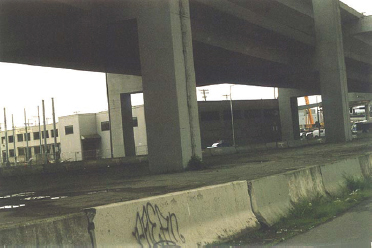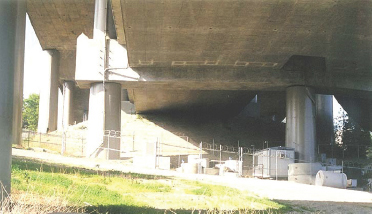 | Dan Hughes |
| Proposal for Skateparks under Bridges |
Skateboarding enthusiast Dan Hughes submitted the following proposal to the city of Seattle. The proposal offers background on the benefits of skateboarding for young people and identifies a problem in the lack of appropriate venues for young skateboarders in the city. The proposal then offers a detailed plan for solving the problem by creating skateparks under bridges and highway overpasses. In structure, style, and tone, the proposal anticipates potential objections from city officials and offers persuasive details to support the plan as a viable solution.
PROPOSAL FOR SKATEPARKS UNDER BRIDGES
BACKGROUND
Skateboarding is a high-energy activity that builds both physical and mental strength, as it requires an individual to be self-reliant while sharing space with other individuals.
Part of what makes skateboarding a positive activity is that it allows people to focus on their personal abilities and skills. As a sport, skateboarding has no prescribed rules, no governing body, and no restrictions that require a team effort. Kids who are not served by team sports are attracted to skateboarding because it doesn’t require them to join a team and compete until a winner and a loser are declared. It is an activity in which there are no losers, only winners. Anyone can simply grab a board and skate anytime to improve his or her skills.
Skateboarding has other positive attributes, as older skaters can attest. It builds confidence, and often it’s this confidence in oneself that allows one to make the right choices in life. It also teaches kids that they can do things they never thought possible. For parents and kids alike, skating also provides opportunities for learning and acting as positive role models. One only has to look at champion skater Tony Hawk to see how skateboarding has become a way for him to connect with his kids.
It is well known that social problems occur in cities when adequate facilities and challenging activities for young people are not available. Skateboarding offers one solution, but skateboarding cannot occur in the rain, or when it’s excessively hot, or in the dark winter months. Ultimately, a well-designed and well-built skatepark is necessary to provide a challenging and safe environment for young skaters. Older skaters would also use and enjoy such a park, and this mix of age groups would give younger skaters the opportunity to learn and grow, not only as skaters but also as people.
PROPOSAL
This proposal puts forth a plan for building skateparks in underutilized spaces under bridges and overpasses in Seattle. Skateparks can take organic, asymmetrical forms; they need not be bound in squares like other sports fields. This key feature allows for more efficient use of space that otherwise may be rendered useless (such as land under bridges or freeways).
Using land under a bridge has two main advantages compared to other skatepark locations. First, it largely eliminates the “N.I.M.B.Y.” (Not In My Back Yard) problem, which happens when local residents do not want loud or disruptive activities near their houses. Because these areas already accommodate a freeway or a noisy bridge, skatepark-generated noise is no longer an issue. Second, skateparks discourage illegal activities that often occur under bridges of this sort. A good example is the area under the Burnside Bridge in Portland. This location was home to all kinds of criminal activity (drug deals, prostitution, abandoned cars, and so on) before Mark Scott and other skaters started building a skatepark there in 1990. The skaters cleaned up the area and kept the criminals out, to the point that the surrounding businesses took notice and volunteered their time and money toward expanding the skatepark. Even the local police chief donated money towards the effort. (This information was taken from a personal interview with Joanne Ferrero, who is owner and operator of Ferrero Equity Inc., a company right next to the Burnside Skatepark.)
In addition to these advantages for cities, using land under bridges and overpasses also provides an advantage for skaters. The bridge provides protection from rain in the winter and excessive heat in the summer. With the addition of lights, the skatepark can be used after dark as well.
OBJECTIVES
- Give skaters a good, covered place to skate that can be used rain or shine, day or night, throughout the year.
- Effectively use space that most wouldn’t think to use as park land. Effective use of this space fulfills the goals of the City by providing a designated area for skateboarders and serves the community by freeing up more land to be used for other types of parks.
- Provide kids with a healthy and intense activity. At skateparks, kids learn how to skateboard and are given a positive kinesthetic and creative outlet for their energy.
PROJECT DETAILS
Suggested Locations
- Under I-90 along Royal Brougham. This area is centrally located with access to public transportation. It features a large covered space that is largely unused.
For a closer look, click on each image to enlarge it.

- Under I-5 between NE 40th Street and NE 42nd St. This area is close to the University District, where there are lots of students who skateboard. It, too, features access to public transportation and a very large covered area that is largely unused.

Clientele
Two different groups would be likely to use skateparks in the suggested locations. The first and most important group is made up of young people who live nearby and who frequently skate in the area already. The second group is made up of skaters of all ages who live in various parts of the city and who would travel to this park (either by car or bus) because it is usable even in the rain, unlike most other outdoor skate parks.
Both clientele groups are essential components of this project, and it is expected that both would make significant use of the skatepark. Skateboarding is currently one of the fastest growing sports, and facilities such as these are used more heavily than basketball courts or baseball fields in similar locations.
Methods
The primary methods for achieving these objectives:
- The design and construction of a skatepark using concrete as its surface material.
- The use of experienced design and contracting companies comprised of skateboarders.
- The development of the area under a bridge as a full-fledged city park, complete with restrooms, trash cans, and lights.
Potential Objections and Responses
Skateparks under bridges are hidden, allowing for illegal activities. As the Burnside skatepark has proven, skateparks under bridges actually discourage crime in these areas. Skateboarders concentrate on their skateboarding, not on illegal activities. Lights, restrooms, picnic tables, a play area for toddlers, and vending machines will attract parents of the kids who are skateboarding. In Newberg, Oregon, this adult-friendly approach has been very successful at promoting self-policing of the skatepark.
Seismic safety. Traffic safety engineers design such bridges specifically to withstand the weight and stress of consistent car travel. If the bridge is safe for auto travel, one can reasonably assume it is safe for skateboarders beneath the bridge.
The land is not the property of the city. Currently there is a skatepark under I-90 in Spokane, Washington, which sets a precedent that Seattle can follow.
A park that attracts people from surrounding cities doesn’t serve Seattle. In fact, it does. A good example is the skate bowl in Ballard Commons Park. Skaters come from all around to skate there, and the surrounding businesses, such as the QFC and Texaco, benefit — as does the city. The bottom line is that skaters spend money when they travel, and if they travel to Seattle, they will spend money in Seattle.
Lights are expensive. Darkness arrives early during Seattle’s winter, just after the school day ends. This causes skaters to look for lighted places to skate, such as the streets or parking garages, both of which are illegal. It’s far better to have the kids in one place like a skatepark, where their parents and the authorities can keep track of them. If lights can be used at a tennis court, then they can be used in the same way for a skatepark. Lights need not stay on all night. They can shut off automatically at a designated time or have a coin-operated switch to turn them on (to help offset the cost).
Needed Resources
- Site Acquisition/Lease from Washington State Department of Transportation or the City of Seattle
- Personnel: No personnel will be needed to staff the park.
- Facilities Maintenance: Emptying trash, cleaning restrooms, changing lights, and so on.
- Design and Construction Costs: Central Contractors Association estimates approx. $15/sq ft.
- Infrastructure Maintenance Costs:
– Skate-only and concrete with steel coping: $0
– Skate-only with pool coping: about $3000 the first year and $2000 a year thereafter
– BMX: about $5000 a year
Additional Possibilities for Sites in Seattle
- Under the Ballard Bridge
- Under Interstate 5 in Seattle along Airport Way
- Under the 12th Street Bridge and Dearborn Ave.
- Under 45th St. next to University Village
- Under Highway 509 at the intersection of Highway 99 and 509 and W. Marginal Way
- Under Highway 99 at South Hanford St.
- Under Hwy 99 at South Atlantic St.
- Under I-5 and Spokane St.
- Under I-5 at Shelby St.
- I-90 next to Rainer Ave. and Goodwill
- Under West Seattle Bridge at Duwammish St.
Dan Hughes
| Starting a Conversation: Respond to “Proposal for Skateparks under Bridges” | |
 | In the text boxes below, evaluate Hughes’s proposal by responding to the following questions: |
Question
What elements of Hughes’s proposal demonstrate his sensitivity to the concerns of skateboarders? What elements demonstrate his awareness of the concerns of city officials?
Question
How would you characterize the structure of this proposal? In what ways does the form — background, problem definition, proposed solution, and so on — help the writer achieve his purpose?
Question
Hughes addresses possible objections to his proposed solution in the section “Potential Objections and Responses.” Where else in the proposal does he address potential objections, and how does he refute them? Can you think of additional possible objections? What questions might remain in readers’ minds?
Question
At several points in his proposal, Hughes refers to examples such as the Ballard Skatepark and the Burnside Skatepark. How do these sources support his claims? What important details, if any, are missing?
Question
Do you think Hughes’s proposal is likely to be accepted or rejected? Why?